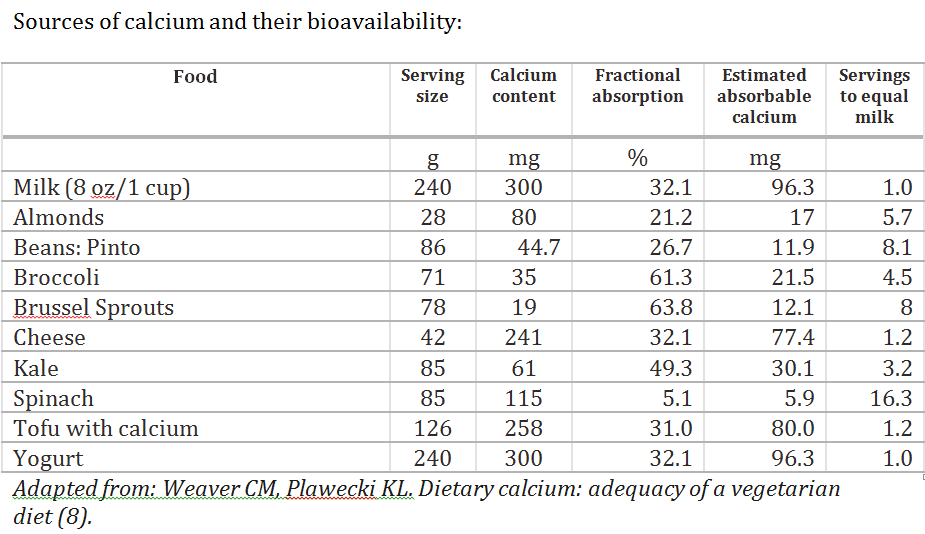We all know that calcium is essential for strong bones and teeth, but what else does it do? How about its critical roles in muscle contractions, nerve impulses, blood clotting, and cellular metabolism?
Recent research has even highlighted its role in weight management, controlling cholesterol and hypertension, along with reducing the risks of certain cancers.
If you are a certified nutrition specialist, your clients will benefit wholeheartedly from more calcium in their diets. Find out more of what calcium does, the recommended dietary intake, and the sources to get it below.
And see this blog post on micronutrients foradditional information on calcium.
What Calcium Does
Skeletal Strength
Bones and teeth are where 99% of the body’s calcium can be found (1,2). Bones are continually remodeling, whether being broken down and going through resorption or being reformed with deposits of calcium (1-3). Bone growth and density increases the most during childhood and adolescences when more bone is deposited than removed (1,2). The bones also serve as the body’s calcium reservoir. Most people have reached their bone mass peak by age 30, after that there is slightly more bone lost than gained during the remodeling process (1,2).
Osteoporosis is when there is a decrease in bone mass and density, and the bones become porous and fragile (1-3). This has a higher incidence in post menopausal women when estrogen and progesterone production declines, but can also be caused by low calcium and vitamin D intake, eating disorders, smoking, too much alcohol, and a lack of physical activity (or bed-rest) (1,3,4).
Developing and maintaining peak bone mass is key in preventing osteoporosis. Active women athletes should also be concerned with the female athlete triad, a syndrome of disordered eating, amenorrhea (loss of normal menstrual cycle), and osteoporosis (1,2,5). This syndrome can happen when female athletes increase their training, and/or decrease their energy and calcium intake, leading to an increased risk of bone fractures (1,5).
Nerve and Muscle Function
Calcium’s positive molecule is important to the transmission of nerve impulses to the muscle fiber via its neurotransmitter triggering release at the junction between the nerves (2,6). Inside the muscle, calcium facilitates the interaction between actin and myosin during contractions (2,6). Recall the protein structures of tropomyosin and troponin, both located on the actin filament. Calcium binds to the troponin, causing a position change in tropomyosin, exposing the actin sites that myosin will attach to for a muscle contraction (5,6).
Blood Clotting
Without calcium blood would not clot. Calcium needs to be present in the blood for the formation of fibrin, an insoluble protein that forms a fibrous network for the blood clot’s framework (2).
And a few more…
Calcium also plays an important role in blood pressure regulation, heart rhythm, cellular metabolism, water balance and immune function, along with energy and fat metabolism (1,2,5).
How Much Calcium Should Get Per Day?
Many people don’t get the recommend daily amounts of calcium, especially women (7). Below is an overview of the daily calcium needs for adolescents and adults.
Though it’s easy enough to see how much calcium is needed on a daily basis, it can be a challenge to track just how much you are actually getting (or losing) because calcium absorption is very inefficient (1,2). Generally, we only absorb between 25% and 35% of the calcium we consume. Calcium absorption can vary due to age (highest during pregnancy and infancy, lowest in old age), presence of vitamin D (increases absorption in the intestine), hormonal status (drop in estrogen for women, low testosterone for men lowers absorption), the body’s need for calcium, and overall calcium intake (inversely related, the more you eat the less you absorb) (1-3).
Foods high in calcium include dairy products, green leafy vegetables, canned fish with bones (sardines, salmon), some tofu products, and calcium-fortified products (1,2,8). Milk is often touted as one of the best sources of calcium, but there are plenty of other non-animal sources- you just may need to eat quite a few servings to get the same amount of bio-available calcium (2,8)! Though high in calcium content, some foods, such as spinach, are poorly absorbed by the body because of the oxalates that are bound to the calcium (2,8).
Read also: What To Look for in a Multivitamin
References:
- Committee to Review Dietary Reference Intakes for Vitamin D and Calcium, Food and Nutrition Board, Institute of Medicine. Dietary Reference Intakes for Calcium and Vitamin D. Washington, DC: National Academy Press, 2010.
- Insel PM, Ross D, McMahon K, et al. (2011). Nutrition (4th edition). Sudbury, MA: Jones and Bartlett.
- Clark M. NASM Essentials of Personal Fitness Training, 4th ed. Baltimore, MD: Lippincott Williams & Wilkins; 2012.
- New Recommended Daily Amounts of Calcium and Vitamin D | NIH MedlinePlus the Magazine. U.S National Library of Medicine. U.S. National Library of Medicine, 2011, 5 (4) 12. Accessed Web. 10 Mar. 2014. www.nlm.nih.gov/medlineplus/magazine/issues/winter11/articles/winter11pg12.html.
- Clark MA, Lucett SC. (2010). NASM’s Essentials of Sports Performance Training. Baltimore, MD: Lippincott Williams & Wilkins.
- Powers SK, Howley ET. (2012). Exercise Physiology: Theory and Application to Fitness and Performance, 8th ed. New York, NY: McGraw-Hill.
- Bailey RL, Dodd KW, Goldman JA, Gahche JJ, Dwyer JT, Moshfegh AJ, Sempos CT, Picciano MF. Estimation of total usual calcium and vitamin D intakes in the United States. J Nutr. 2010 Apr;140(4):817-22.
- Weaver CM, Plawecki KL. Dietary calcium: adequacy of a vegetarian diet. Am J Clin Nutr 1994;59(suppl):1238S–41S.


















